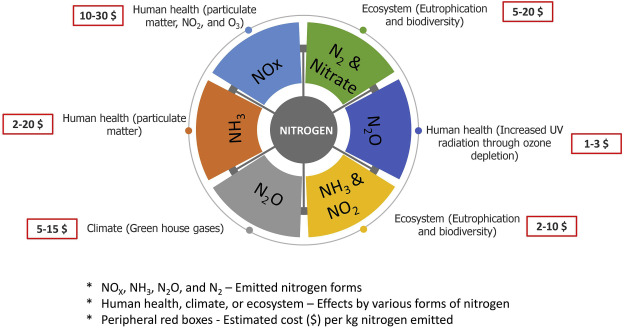
Fertilisers and pesticides

Fertilisers emit greenhouse gases in multiple ways – the fossil fuels used in their manufacture, transportation and application, and the gases they themselves directly emit – particularly nitrous oxide, which is more than 296 times more noxious than carbon dioxide1 because of its long lifespan and strong infrared absorption. By 2015, nitrous oxide made up 8% of anthropogenic climate forcing from greenhouse gas emissions, and is set to raise global temperatures by 0.4deg by 2100.2 Nitrous oxide is now the third largest contributor to human-induced climate change, and approximately 70% of all N2O emissions in the US come from agriculture.3
The damage doesn’t stop with direct emissions. Much of the nitrogen cannot be absorbed by the crops and both leaches into the soil and runs off into rivers and lakes, cascading through multiple ecosystems.4Agrochemical residues cause significant contamination of terrestrial and coastal aquatic ecosystems.5
As the nutrients reach the ocean, they can create dead zones. Even further out, the less oxygenated the ocean becomes, the less carbon dioxide it can absorb from the atmosphere, worsening the vicious circle of climate change.

Pesticides are commonly known as a threat to animal and human health, but they also play a significant role in climate change. Fossil fuels are used in their manufacture, transport and application; one study of insecticide use against soybean aphid in the US results in 10.6kg CO2 equivalent per hectare of soybeans treated, amounting to peak annual emissions of 40 million kg of CO2 equivalent.6
Another study calculated overall pesticide energy inputs to be 1364 megajoules per hectare, producing a weighted average greenhouse gas emission of 94 kg CO2 equivalent per hectare of arable crop. It showed that pesticide manufacturing represents about 9% of the energy use of arable crops, and about 3% of the 100-year Global Warming Potential (GWP) from crops.7

Over time, pesticide use decreases biodiversity in soil, and the less fertile soil requires additional use of fertilizer. Some pesticides emit compounds that react with other chemicals in the atmosphere to create tropospheric ozone, a greenhouse gas that can lengthen the time how long methane and other hydrocarbons remain in the atmosphere. The chemicals in pesticides also leach into the soil and eventually into the sea, where they contribute to the rising acidity of ocean surface waters; a study of Nicaraguan cotton crops showed toxaphene remained in soils for many years and eventually contaminated aquatic biota in watersheds and coastal lagoons.4
Climate change decreases the effectiveness of pesticides, in part by increasing the voltinism of pests, which then speeds the development of resistance to the chemicals in pests.8
REFERENCES
- 1.Watson, R.T. and the Core Writing Team (Eds). IPCC Third Assessment Report: Climate Change 2001. Cambridge University Press; 2001:1-398. Accessed 2021. https://www.ipcc.ch/report/ar3/wg2/
- 2.U.S. Environmental Protection Agency. Inventory of US Greenhouse Gas Emissions and Sinks: 1900‐2013. U.S. Environmental Protection Agency; 2019:All. https://www.epa.gov/sites/production/files/2019-04/documents/us-ghg-inventory-2019-main-text.pdf
- 3.Reay D. Nitrous Oxide as a Driver of Climate Change. In: Nitrogen and Climate Change. Palgrave Macmillan UK; 2015:39-47. doi:10.1057/9781137286963_4
- 4.Carvalho FP. Pesticides, environment, and food safety. Food Energy Secur. Published online May 2017:48-60. doi:10.1002/fes3.108
- 5.Birch MBL, Gramig BM, Moomaw WR, Doering, III OC, Reeling CJ. Why Metrics Matter: Evaluating Policy Choices for Reactive Nitrogen in the Chesapeake Bay Watershed†. Environ Sci Technol. Published online January 2011:168-174. doi:10.1021/es101472z
- 6.Heimpel GE, Yang Y, Hill JD, Ragsdale DW. Environmental Consequences of Invasive Species: Greenhouse Gas Emissions of Insecticide Use and the Role of Biological Control in Reducing Emissions. Palli SR, ed. PLoS ONE. Published online August 20, 2013:e72293. doi:10.1371/journal.pone.0072293
- 7.E. Audsley, K. Stacey, D.J. Parsons, A.G. Williams. Estimation of the Greenhouse Gas Emissions from Agricultural Pesticide Manufacture and Use. Cranfield University; 2009:1-20. Accessed 2021. http://dspace.lib.cranfield.ac.uk/handle/1826/3913
- 8.Maino JL, Umina PA, Hoffmann AA. Climate contributes to the evolution of pesticide resistance. Global Ecol Biogeogr. Published online December 6, 2017:223-232. doi:10.1111/geb.12692